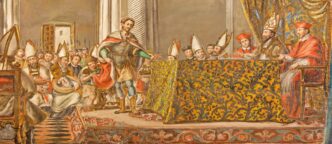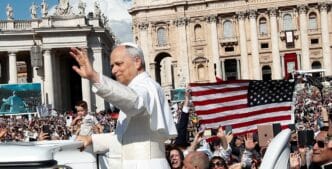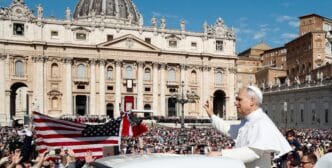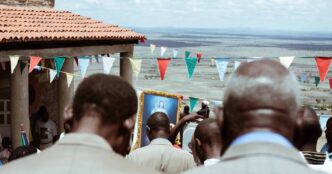“I suppose they could put it on my tombstone: ‘The man who ordained the pope.'”
With a wry smile, Archbishop James P. Green recalled the day he laid hands on an Augustinian missionary in Peru — never imagining that the man he was ordaining a bishop would one day lead the Catholic Church.
When Archbishop Green arrived in Peru as apostolic nuncio, he stepped into one of the most historically rich and spiritually vibrant churches in South America. “Peru is a big church. A great church,” he told Our Sunday Visitor. “It was the stronghold of Spain in South America — the viceroyalty. It has a deep Catholic identity, and it shows.”
Green had previously served as nuncio in South Africa and surrounding nations, but the ecclesial terrain in Peru posed new challenges, from complex episcopal appointments to tense negotiations with Catholic institutions. One of the most pressing concerns at the time was the situation with the Pontifical Catholic University of Peru in Lima, which had long-standing disputes with the Vatican over governance and identity. “It needed a lot of work between the hierarchy and the administration of the university,” he recalled. “It was complicated.”
But no task loomed larger than selecting bishops — a central duty of any papal nuncio. With Peru’s diverse geography stretching from the Amazon to the Andes to the Pacific coast, the country presented not only logistical challenges but also pastoral ones. “You really needed bishops who were close to the people, who could work with both the clergy and the faithful. A pastoral heart was essential,” Green said.
Many dioceses in Peru had traditionally been overseen by religious orders, particularly the Franciscans, Dominicans and Augustinians. But with the decline in vocations, the nuncio often found himself in need of new solutions. One such case would ultimately lead to the historic appointment of Robert Francis Prevost, the American Augustinian missionary who would one day become a cardinal and later Pope Leo XIV.
Appointing the right man to the job
“I knew Father Prevost from Rome, where he had served as prior general of the Augustinians,” Green said. “He had spent many years in Peru and loved the country deeply. His Spanish was flawless. Even though he had never served in the diocese of Chiclayo, I knew in my heart that he was a Peruvian in spirit.”
Green discussed his consideration of Prevost with Pope Francis during a regular visit to Rome. “We were talking about vacant dioceses in Peru, and I mentioned Chiclayo,” Green recalled. “The Holy Father said he knew it well. When I mentioned Father Prevost, his eyes lit up. He remembered him from previous meetings in South America and said, ‘Yes, I know him. He’s Augustinian, right?’ And I said, ‘That’s right.'”
Pope Francis gave his immediate assent. “Do you think he’s the right man?” the pope asked. “I do,” replied Green. “Then I’ll appoint him.”

But there was one administrative hurdle. At the time, Prevost was not a Peruvian citizen — a requirement under the concordat between Peru and the Holy See. To work around this, Prevost was appointed apostolic administrator of Chiclayo and ordained a bishop while working to complete his naturalization process. “A few months later, he got his citizenship, and we were able to make him diocesan bishop officially,” Green explained.
That ordination day, set for December 12 on the Feast of Our Lady of Guadalupe, was deeply meaningful. “He asked me to ordain him,” Green said. “Sometimes, the new bishop will ask a predecessor, or the metropolitan, or a fellow religious, but he asked me. And I was honored.” With a smile, he added, “I suppose they could put on my tombstone: ‘The man who ordained the pope.'”
A special ‘ability to bring people together’
Green stayed in Peru for three more years and saw firsthand Prevost’s pastoral leadership. “He had a tremendous ability to bring people together. He talked about building bridges, and he lived it. He knew how to handle differences of opinion among bishops and clergy with grace and unity.”
Looking back, Green reflected on how Prevost’s experience as prior general had broadened his vision for the universal Church — something, he noted, that is essential in the role he now holds in Rome. “Being in that role, you get to see the Church across the world. That kind of vision prepares you for something much bigger.”
As for what Pope Leo might offer the Church in the United States, Green replied: “First, he reminds us that there are many ways to be the Church. We need to move beyond thinking there’s only one model of Catholicism. And second, we need to trust him — and Pope Francis. Respect for the pope is part of our faith, and our prayers for him are not optional.”
After forty-two years serving the Vatican’s diplomatic corps, Green remains a witness to how providence moves through the quiet discernment and unseen labor of the Church’s mission. In the case of Father Robert Prevost, he saw something early. “No,” he laughed, “I didn’t know he’d become pope — or a cardinal for that matter. But he had the qualities. And now, he has the responsibility. That’s how the Lord works.”








